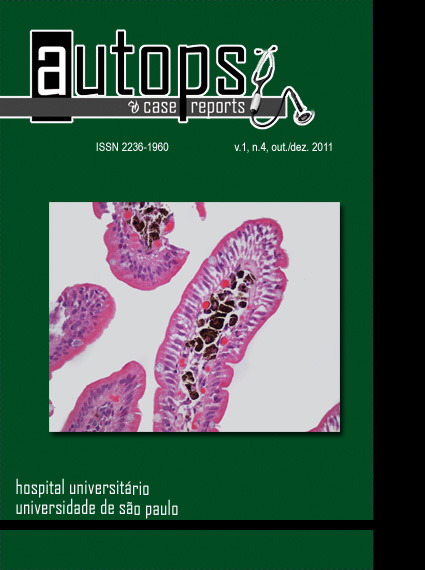Primary aortoesophageal fistula: a rare cause of acute upper gastrointestinal bleeding
DOI:
https://doi.org/10.4322/acr.%25y.26077Keywords:
Aortic aneurysm, Atherosclerosis, Esophageal fistula, Gastrointestinal hemorrhageAbstract
Acute upper gastrointestinal bleeding is a potentially life-threateningemergency, especially in the elderly. This condition accounts for approximately
1% of all emergency room admissions. Among the causes of such bleeding
is aortoesophageal fistula, a dreaded but apparently rare condition, first
recognized in 1818. The great majority of cases are of primary aortoesophageal
fistula, caused by atheromatous aortic aneurysms or, less frequently, by
penetrating aortic ulcer. The clinical presentation of aortoesophageal fistula
is typically characterized by the so-called Chiari’s triad, consisting of thoracic
pain followed by herald bleeding, a variable, short symptom-free interval,
and fatal exsanguinating hemorrhage. The prognosis is poor, the in-hospital
mortality rate being 60%. Conservative treatment does not prolong survival,
and the in-hospital mortality rate is 40% for patients submitted to conventional
surgical treatment. Here, we report the case of a 93-year-old woman who
presented to the emergency room with a history of hematemesis. The patient
was first submitted to upper gastrointestinal endoscopy, the findings of which
were suggestive of aortoesophageal fistula. The diagnosis was confirmed
by multidetector computed tomography of the chest. Surgery was indicated.
However, on the way to the operating room, the patient presented with massive
bleeding and went into cardiac arrest, which resulted in her death.
Downloads
Download data is not yet available.
Downloads
Published
2011-12-19
Issue
Section
Article / Clinical Case Report
License
Copyright
Authors of articles published by Autopsy and Case Report retain the copyright of their work without restrictions, licensing it under the Creative Commons Attribution License - CC-BY, which allows articles to be re-used and re-distributed without restriction, as long as the original work is correctly cited.
How to Cite
Gomes, S. I. M., Campos, F. P. F. de, Martines, B. M. R., Martines, J. A. dos S., Tafner, E., & Maruta, L. M. (2011). Primary aortoesophageal fistula: a rare cause of acute upper gastrointestinal bleeding. Autopsy and Case Reports, 1(4), 57-63. https://doi.org/10.4322/acr.%y.26077



